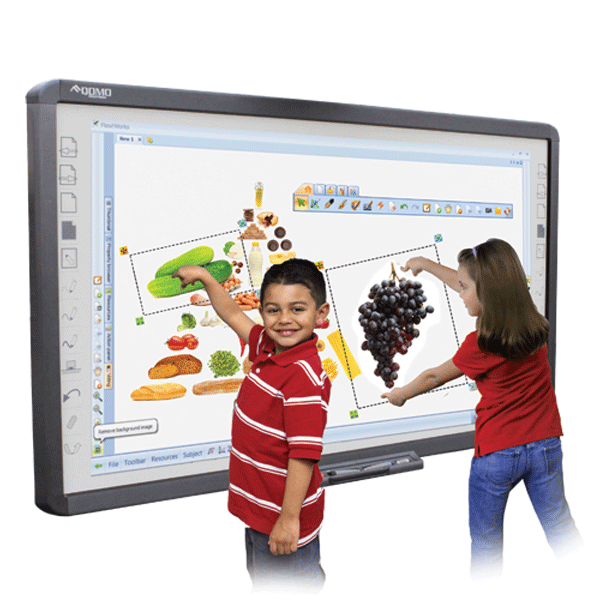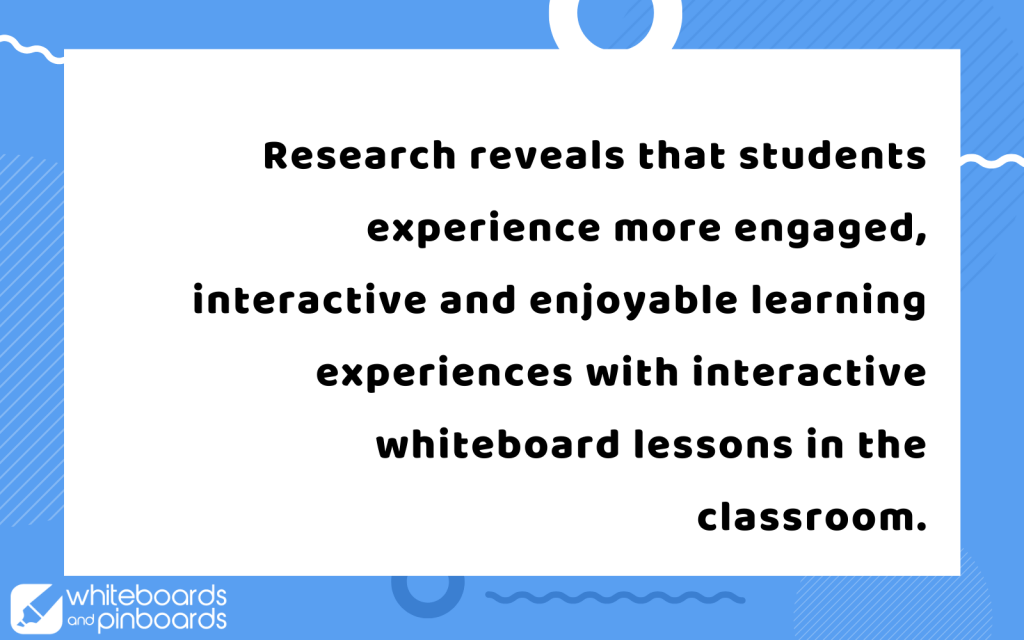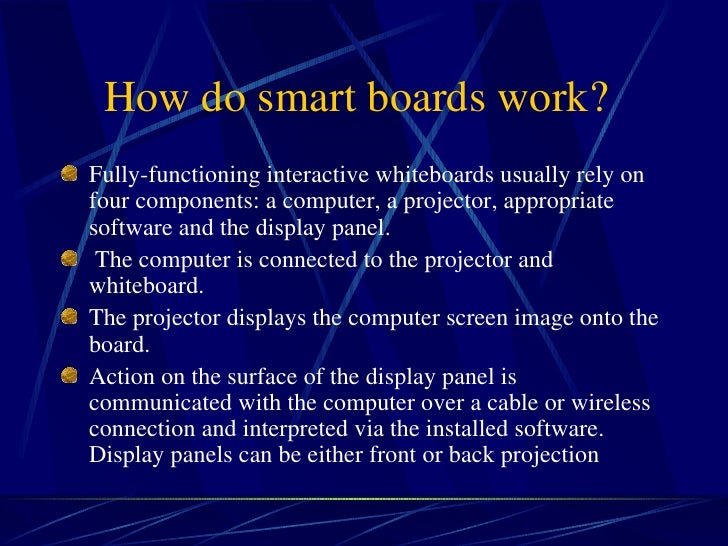Interactive whiteboards are desirable peripherals these days. When hooked up to a computer, the whiteboard's screen becomes a 'live' computer desktop, which can be tapped to pull down menus, highlight, and move or open files. Users can also circle relevant sections on the projected image, draw geometric figures, and underline. Using Gestures with Your SMART Board ® Interactive Whiteboard. On most of the newer models and software versions on computers with more recent operating systems, you can interact with objects on your SMART Board interactive whiteboard and in SMART Notebook ™ software using the following gestures: Swipes. Zoom in/enlarge. Zoom out/reduce.
- Interactive Whiteboards For Schools
- How Does An Interactive Whiteboard Work
- How Does An Interactive Whiteboard Work For A

The first interactive whiteboard was released in 1991, and as recently as a few years ago, it appeared that the technology was cementing itself as a permanent mainstay in the classroom — helping teachers to embrace technology and promoting 21st Century skills in students. A number of districts around the country placed the tools in all of their classrooms, and teacher professional development programs were reshaped around the technology.
Fast-forward to today, and the market has shifted. While a number of schools continue to use interactive whiteboards, many are transitioned to interactive digital displays—which look more like flat-panel TVs or jumbo-sized tablets than dry erase boards—as they fund new purchases. Several interactive whiteboard makers have either gone out of business or shifted their own strategies, and even SMART Technologies (whose SMART Boards came to be synonymous with interactive whiteboards) has embraced interactive digital displays.
“If you go to a major trade show, you’ll be hard-pressed to find interactive whiteboards anymore,” says Stephen Yao, head of product marketing for SMART Technologies. “If you look at price points 10 years ago, if you were to buy a large touchscreen, it would have set you back $20,000 or $30,000 for a 78- or 80-inch display. Today, you might be able to get a 65-inch display for under $3,000. It’s a stark difference.”
The good news for educators: This doesn’t really matter. It’s true that there are some advantages to digital displays. For one, they can be moved easily without having to recalibrate a projector. They don’t require replacement bulbs and their screens are sometimes easier to see in direct light than older interactive whiteboard displays. But, from an instructional standpoint, digital displays and traditional interactive whiteboards are interchangeable.
“It’s the same approach,” says Yao. “All our displays come with pens that you can use to write on the screen. If you misplace the pen, you can use your finger to write. And for students who need certain accommodations, you can you use third-party objects, like a tennis ball.”
Anything that can be done on a computer monitor can be replicated on an interactive whiteboard or interactive digital display. A teacher can create engaging lessons that focus on one task, such as a matching activity where students use either their fingers or a pen to match items. Another teacher might integrate multiple items into a lesson, such as websites, photos and music, that students can interact with, respond to verbally or even write comments on the board itself. Image size and placement can change with a simple touch to the screen. This technology makes the one-computer classroom a workable instructional model. Imagine taking a class on a photo safari to Africa complete with embedded videos, animal sounds and mapping software.
Research has repeatedly demonstrated that students learn better when they are fully engaged and that multisensory, hands-on learning is the best way to engage them. Interactive whiteboards facilitate multisensory learning whether it is a collaboration exercise for math problem solving or a Google Earth tour of the Amazon rainforest.

Classroom applications for using interactive whiteboards and digital displays include:
- Multimedia lessons and presentations including audio and video
- Collaborative problem solving
- Showcasing student projects and presentations
- Virtual field trips
- Recorded lessons that can be used by substitute teachers
- Documentation of student achievement
Jenny Hand, an elementary school teacher in Missouri, still uses a SMART interactive whiteboard in her classroom, although her district is in the process of switching to digital displays. “Right now, people aren’t very excited about the switch, because this means having to switch over everything they’ve saved for the last several years in the SMART software to their Google Drive,” she says. “But this will eventually be a benefit, since everything in the district is being saved on Google.”
Hand says she uses her interactive whiteboard several times each day—writing a “Morning Message” to students, reading poems and letting students circle rhyming words on the board, showing phonics videos, playing math games and more. “It helps me reach kids using different learning strategies, while keeping the learning fun and engaging,” she says.
Michele Hendrickson, a first-grade teacher in Iowa, previously had an interactive whiteboard from maker Promethean, but her district recently switched to the company’s ActivPanel digital displays. “The screen is much clearer, and numerous students can interact with it at once,” she says. Hendrickson uses the panel to let students work through interactive math and reading programs, and for simple tasks like taking attendance. (Each student’s name is written on a seasonal digital object, such as a leaf, and students place their leaves into a digital “pile” when they enter the classroom to show that they are present.)
Interactive Whiteboards For Schools
“We received the ActivPanels last year, and are still learning new things all the time,” Hendrickson says.
There are interactive whiteboards and digital displays that meet every school and district budget. Teachers report that increased student engagement is the number one benefit to teaching with these tools. The technology allows teachers to integrate multiple information streams into a coherent lesson individualized for their students and they provide an extraordinary opportunity to create classroom environments where students with different learning styles can engage and learn from each other.
Interactive Whiteboard Work?
Interactive whiteboards are generally white-colored, large writable display screens that usually connected to a computer, enabling its screen to get displayed on the board through a projector. These are normally hung on a wall or mounted on a floor. By using interactive whiteboards visual presentations are delivered on different topics, engaging a group of audiences or participants. The modern technology used in these boards offers an improved replacement for conventional flip charts or traditional whiteboards. These days, one can find a plethora of branded interactive whiteboards in the market. Some of the famous brands are ActivBoard, SMART Board, Mimio, eBeam, and Webster. “How Does An Interactive Whiteboard Work? – My Kris Tech”.
The interactive whiteboard must be calibrated first with a writing tool (usually a stylus) in order to control the computer while writing or drawing on it. Besides this writing device, there are lots of components associated with interactive whiteboard’s operation.
How Does An Interactive Whiteboard Work
Alignment and accessories of Interactive Whiteboard:

It is important to align the touch screen surface of the interactive whiteboards with the picture or the image to be shown or displayed. This calibration or alignment involves illustrating a wide array of dots on the surface of the board’s touch screen. The user/instructor is allowed to mark or select the dots with a finger or a stylus. “How Does An Interactive Whiteboard Work? – My Kris Tech”.
When it comes to the associated devices or accessories available for use with the interactive whiteboards, you can find a lot of them in the market including projectors, mobile stands, tracks, tablets, printers, wireless units, personal response systems, and remote controls. One can find some interactive whiteboards that aid direct integration with learner response systems enabling the students to participate in the examinations and tests after a session or resolve puzzles or other problems with ease. You can also find classroom response software in the market, which can be used with interactive whiteboards in order to develop and arrange tests and activities based on various standards.

Operation Principle of Interactive Whiteboard:
An interactive whiteboard, when associated with the computer, writing device, software, and other components, turned into a complete interactive whiteboard system that can be utilized to conduct a teaching/learning session. The interactive whiteboard system comprises of four key components- that are computer, projector, software, and the display screen. The board is connected to a data projector, which is then linked to a laptop or personal computer (PC). The connection is made by making use of a wired medium that could be a universal serial bus (USB) or a serial port cable. “How Does An Interactive Whiteboard Work? – My Kris Tech”.
How Does An Interactive Whiteboard Work For A
Wireless interactive whiteboards can also be linked to the components wirelessly, using infrared waves or Bluetooth. The data projector projects the information including pictures/ diagrams, numbers, statistics, symbols, characters, etc. exhibited on the computer screen onto the whiteboard’s surface. The operating software is mainly used to make any modifications or changes in the projected images and reflect the manipulated data stored on the computer. Some advanced interactive whiteboard systems use plasma screens instead of projectors. “How Does An Interactive Whiteboard Work? – My Kris Tech”.

A presentation delivered using an interactive whiteboard may consist of color visuals, video clips, or content from the Internet. Interactive display screens of the boards are highly touch-sensitive. Therefore, the instructor or the user who is conveying the presentation uses a pointing device such as a stylus, pen, or a finger, which perform like a mouse and handles the computing device programs from the board. The user can do modifications, additions, or deletions to the contents, images, or information projected on the interactive whiteboard, and the rectification thus made are sifted and saved onto the laptop or personal computer for future recovery.“How Does An Interactive Whiteboard Work? – My Kris Tech”.